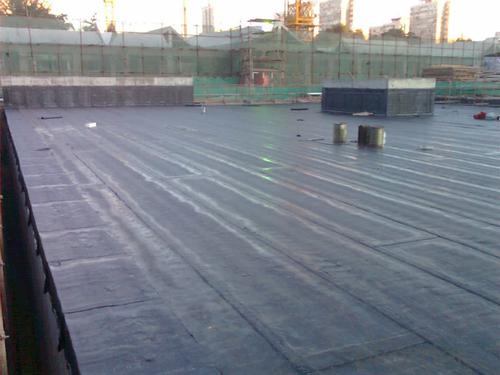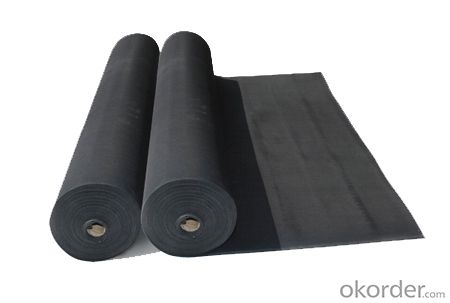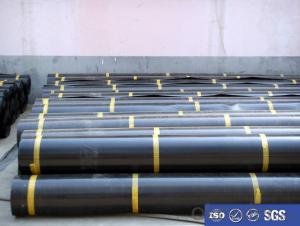EPDM Waterproof Membrane with Fleeced Back for Roofing
- Loading Port:
- Shanghai
- Payment Terms:
- TT OR LC
- Min Order Qty:
- 20000 m²
- Supply Capability:
- 5000000 m²/month
OKorder Service Pledge
OKorder Financial Service
You Might Also Like
EPDM Waterproof Membrane with Fleeced Back for Roofing
Description Of EPDM Waterproof Membrane with Fleeced Back for Roofing:
We have more than 15 years experience in development & manufacture construction materials such as waterproof membrane,waterproof coils,waterproof panels,waterproof coating,geomembrane,geotextiles etc.Depending on our full set production line,well equipped laboratory,cooperation with institute&college and experienced employees,we have successfully developed and consolidated domestic and foreign market.With a high-tech team of research and development,we have our patent technology, the spray application waterproof membrane.They are the most advanced technology in tunnel and underground projects.Quality is our life,customer satisfaction is our goal, to build the world be more beautiful is our responsibility!
Main Features of EPDM Waterproof Membrane with Fleeced Back for Roofing:
1.Excellent anti aging performance ,service life up to 50 years.
2.High extension rate,high tensile strength ,small size changes at heat treatment.
3.Good plant roots penetrability resistance and can be made waterproofing layer of planting roof.
4.Special modified molecular structure ,effectively resolving the current domestic and foreign glue joint problem.
5.Good low temperature flexibility ,and good performance of adapting to ambient temperature changes.
6.Convenient application ,solid joint ,no environment pollution.
7.Chemical corrosion resistance ,can be used for special occasions.
8.Good anti-perforated.
Specifications of EPDM Waterproof Membrane with Fleeced Back for Roofing:
| Material | EPDM Rubber |
| Size | 1.2m (width)*20m (length) or customized, weldable type 2.05m or 4m width |
| Thick | 1.2mm, 1.5mm, 2.0mm |
| Type | Vulcanized & Weldable |
| Pattern | Non-reinforced (homogeneous) |
| Certificate | ISO9001/14001 |
Applications of EPDM Waterproof Membrane with Fleeced Back for Roofing:
1. Roofs, Basement, Toilet
2. Industrial and civil building waterproofing
3. Geo-synthetic liner for swimming pool, channels, irrigation system
4. Especially suit for projects with high requirements in durability, anti-corrosion and deformation



IMages of EPDM Waterproof Membrane with Fleeced Back for Roofing:




FAQ of EPDM Waterproof Membrane with Fleeced Back for Roofing:
1. What are we supplying?
We are specialized in producing Colorful Asphalt Roof Shingle, SBS/APP modified bitumen waterproof membrane, Self adhesive bitumen waterproof membrane, PVC waterproofing membrane, EPDM rubber roofing membrane, Single Component Polyurethane Waterproof Coating, and Spray Polyurea Waterproof Coating
.
2. How Many years experience do we have?
We have been exported to more than 20 countries in the past 15 years.
3. How long do we usually reply your request?
We always reply our customer within 24 hours.
- Q: Can a waterproofing membrane be used in areas with vehicular traffic?
- Yes, a waterproofing membrane can be used in areas with vehicular traffic. Waterproofing membranes are designed to provide a protective barrier against water infiltration and can be applied in various settings, including areas exposed to vehicular traffic. However, it is important to choose a membrane that is specifically designed for heavy-duty or high-traffic areas to ensure its durability and effectiveness.
- Q: Are waterproofing membranes resistant to chlorine exposure?
- The resistance of waterproofing membranes to chlorine exposure can vary. Certain membranes are designed to withstand chlorine and are commonly used in areas like pool decks or water treatment facilities where chlorine exposure is expected. These membranes are typically made with materials like PVC or TPO that naturally resist chlorine and can endure prolonged exposure without significant damage. It is important to be aware that not all waterproofing membranes are resistant to chlorine. Some membranes, particularly those made with materials like EPDM or bitumen, may not hold up as well against chlorine and may deteriorate or sustain damage with extended exposure. To ensure a waterproofing membrane lasts and performs well in a chlorine-rich environment, it is vital to choose a membrane specifically designed and tested for chlorine resistance. Seeking guidance from a waterproofing professional or manufacturer can assist in determining the most suitable membrane for the particular chlorine exposure conditions.
- Q: Is a waterproofing membrane resistant to hydrocarbons or oil spills?
- Typically, a waterproofing membrane exhibits resistance against hydrocarbons and oil spills. Its primary purpose is to create a barrier that prevents water penetration and protects the underlying surfaces from moisture damage. These membranes are commonly made from materials such as modified bitumen, polyurethane, or PVC, all of which possess excellent chemical resistance, including towards hydrocarbons and oil. This resistance guarantees that the membrane remains intact and effective even when exposed to substances like oil spills or hydrocarbon-based liquids. However, it is crucial to note that the specific resistance may vary depending on the type and quality of the selected waterproofing membrane. Therefore, it is essential to choose a membrane that is specifically engineered to withstand the intended environment and potential chemical exposures.
- Q: Can waterproofing membranes be used on outdoor fountains?
- Yes, waterproofing membranes can be used on outdoor fountains. These membranes are designed to provide a protective barrier against water, preventing leakage and ensuring the longevity of the fountain. Applying a waterproofing membrane can help to seal any cracks or gaps, keeping the water contained within the fountain and preventing any damage to the surrounding area.
- Q: Can a waterproofing membrane be used for a basement?
- Basements can indeed benefit from the use of a waterproofing membrane. It is highly recommended to employ this method in order to avoid water infiltration and the accumulation of moisture. A waterproofing membrane consists of a thin layer of material that is applied to the walls and floor of the basement, serving as a barrier against water. This layer acts as a protective shield, preventing water from penetrating the walls and causing harm to the foundation and interior of the basement. Furthermore, the use of a waterproofing membrane can also decrease the likelihood of mold and mildew growth, as it maintains a dry and moisture-free environment in the basement. In conclusion, the utilization of a waterproofing membrane is an effective remedy for ensuring waterproof basements and providing a safe and dry living space.
- Q: Can a waterproofing membrane be used on elevator pits?
- Indeed, elevator pits can benefit from the utilization of a waterproofing membrane. Given their subterranean position and susceptibility to water infiltration, elevator pits are prone to water damage. By implementing a waterproofing membrane within the elevator pit, the structure can be shielded from water damage, consequently averting issues like corrosion, mold proliferation, and deterioration. Acting as a barrier, the membrane obstructs water from permeating the pit, thereby preventing harm to the elevator apparatus or the surrounding edifice. It is vital to meticulously select a waterproofing membrane specifically engineered for subterranean applications and ensure the installation adheres to proper protocols to achieve effective waterproofing in elevator pits.
- Q: Is a waterproofing membrane resistant to UV radiation?
- Typically, a waterproofing membrane is resistant to UV radiation. Most manufacturers design these membranes to be durable and long-lasting, ensuring they can withstand exposure to UV rays. Over time, UV radiation from the sun can cause degradation and damage to various materials, including waterproofing membranes. To combat this, manufacturers often include UV stabilizers and additives in the membrane's composition. These additives prevent the breakdown of the membrane's structure, allowing it to remain effective in preventing water infiltration and maintaining its performance for an extended period, even when exposed to direct sunlight. Some waterproofing membranes may also have a protective layer or coating that offers extra UV resistance. To understand the specific UV resistance capabilities of a particular waterproofing membrane, it is advisable to consult the manufacturer's specifications and guidelines.
- Q: Can a waterproofing membrane be used on both interior and exterior walls?
- Yes, a waterproofing membrane can be used on both interior and exterior walls. The membrane helps prevent water penetration, providing protection against moisture for both sides of the wall.
- Q: Can a waterproofing membrane be used for planter boxes and green roofs?
- Yes, a waterproofing membrane can be used for planter boxes and green roofs. In fact, it is highly recommended to use a waterproofing membrane in these applications to prevent water leakage and damage to the underlying structures. Planter boxes and green roofs often require a reliable waterproofing system to ensure the longevity and functionality of the design. A waterproofing membrane acts as a barrier, preventing water from seeping into the underlying structures and causing potential damage. For planter boxes, a waterproofing membrane is essential to prevent water from leaking out and damaging the surrounding structures. It also helps to retain the moisture within the planter box, ensuring that plants receive adequate hydration. Similarly, green roofs require a waterproofing membrane to prevent water from infiltrating the roof structure and potentially causing leaks or structural damage. The membrane acts as a protective layer, ensuring that water is properly drained and does not accumulate on the roof surface. When selecting a waterproofing membrane for planter boxes and green roofs, it is important to consider factors such as durability, flexibility, and resistance to root penetration. Some membranes are specifically designed for these applications, providing additional features like root barriers to prevent plant roots from penetrating and damaging the membrane. In conclusion, a waterproofing membrane is an essential component for planter boxes and green roofs. It helps to prevent water leakage, retain moisture, and protect the underlying structures from potential damage caused by water infiltration.
- Q: Can a waterproofing membrane be used in planters or garden beds?
- Yes, a waterproofing membrane can be used in planters or garden beds to prevent water leakage and protect the surrounding areas. It helps to retain moisture in the soil and prevents water damage to the planter or garden bed structure.
Send your message to us
EPDM Waterproof Membrane with Fleeced Back for Roofing
- Loading Port:
- Shanghai
- Payment Terms:
- TT OR LC
- Min Order Qty:
- 20000 m²
- Supply Capability:
- 5000000 m²/month
OKorder Service Pledge
OKorder Financial Service
Similar products
Hot products
Hot Searches
Related keywords

































